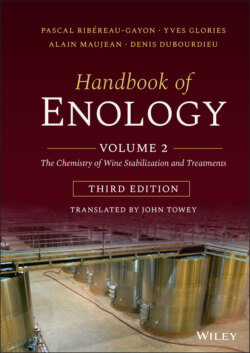Читать книгу Handbook of Enology, Volume 2 - Pascal Ribéreau-Gayon - Страница 10
Оглавление
PREFACE TO THE SECOND EDITION
The two‐volume Enology Handbook was published simultaneously in Spanish, French, and Italian in 1999 and has been reprinted several times. The Handbook has apparently been popular with students as an educational reference book, as well as with winemakers, as a source of practical solutions to their specific technical problems and scientific explanations of the phenomena involved.
It was felt appropriate at this stage to prepare an updated, reviewed, corrected version, including the latest enological knowledge, to reflect the many new research findings in this very active field. The outline and design of both volumes remain the same. Some chapters have changed relatively little as the authors decided there had not been any significant new developments, while others have been modified much more extensively, either to clarify and improve the text or, more usually, to include new research findings and their practical applications. Entirely new sections have been inserted in some chapters.
We have made every effort to maintain the same approach as we did in the first edition, reflecting the ethos of enology research in Bordeaux. We use indisputable scientific evidence in microbiology, biochemistry, and chemistry to explain the details of mechanisms involved in grape ripening, fermentations and other winemaking operations, aging, and stabilization. The aim is to help winemakers achieve greater control over the various stages in winemaking and choose the solution best suited to each situation. Quite remarkably, this scientific approach, most intensively applied in making the finest wines, has resulted in an enhanced capacity to bring out the full quality and character of individual terroirs. Scientific winemaking has not resulted in standardization or leveling of quality. On the contrary, by making it possible to correct defects and eliminate technical imperfections, it has revealed the specific qualities of the grapes harvested in different vineyards, directly related to the variety and terroir, more than ever before.
Interest in wine in recent decades has gone beyond considerations of mere quality and taken on a truly cultural dimension. This has led some people to promote the use of a variety of techniques that do not necessarily represent significant progress in winemaking. Some of these are simply modified forms of processes that have been known for many years. Others do not have a sufficiently reliable scientific interpretation, nor are their applications clearly defined. In this Handbook, we have only included rigorously tested techniques, clearly specifying the optimum conditions for their utilization.
As in the previous edition, we deliberately omitted three significant aspects of enology: wine analysis, tasting, and winery engineering. In view of their importance, these topics will each be covered in separate publications.
The authors would like to take the opportunity of the publication of this new edition of Volume 1 to thank all those who have contributed to updating this work:
Marina Bely for her work on fermentation kinetics and the production of volatile acidity (Sections 2.3.4 and 14.2.5).
Isabelle Masneuf for her investigation of the yeasts' nitrogen supply (Section 3.4.2).
Gilles de Revel for elucidating the chemistry of SO2, particularly details of combination reactions (Section 8.4).
Gilles Masson for the section on rosé wines (Section 14.1).
Cornelis Van Leeuwen for the impact of vineyard water supply on grape ripening (Section 10.4.6).
André Brugirard for the section on French fortified wines—vins doux naturels (Section 14.4.2).
Paulo Barros and João Nicolau de Almeida for their work on Port (Section 14.4.3).
Justo F. Casas Lucas for the section on Sherry (Section 14.5.2).
Alain Maujean for his in‐depth revision of the section on Champagne (Section 14.3).
Bordeaux, May 17, 2004
Professor Pascal Ribéreau‐Gayon
Corresponding Member of the Institut de France Member of the French Academy of Agriculture
